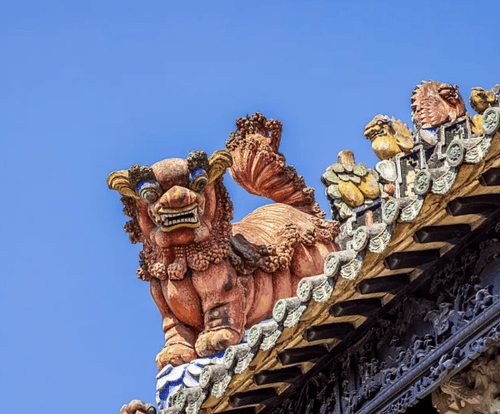
Chen Clan Ancestral Hall — A Frozen Art Treasury and the Heartbeat of Lingnan Culture in Guangzhou
Chen Clan Ancestral Hall: A Frozen Art Treasury and the Heartbeat of Lingnan Culture in Guangzhou
Dear Global Explorers,
I’m thrilled to share with you a truly magical place in the heart of Guangzhou: the Chen Clan Ancestral Hall (Chen Jia Ci), also known as the Chen Clan Academy.
If you are interested in Chinese history, architecture, and exquisite folk art, a visit here will be an unforgettable experience. This is not a cold, remote historical site; it’s a living Lingnan Architectural Museum—a three-dimensional textbook that allows you to step inside and slowly read the stories of history, life, and art intertwined.
Let’s dive into this captivating, story-filled ancient complex, exploring its history, art, culture, and tips for your visit.
I. Echoes of History: The Birth and Mission of a Clan's "City Home"
The history of the Chen Clan Ancestral Hall, though dating back only to the late Qing Dynasty (construction started in 1888 and finished in 1894), is deeply rooted in traditional Chinese society.
The Power of the Clan and a Collective Dream
You might wonder how such a grand and ornate structure came to be.
It was not built by an emperor or a single wealthy merchant. It was a joint project, an "All-Clan Ancestral Hall," funded collectively by Chen family members from 72 counties across Guangdong Province. This ambitious fundraising effort highlights the incredible solidarity and power of the "clan system" (Zongzu) in traditional Chinese society.
Understanding the "Academy" and the "Imperial Exam"
The initial function of Chen Clan Hall was to serve the young men of the clan. At the time, the greatest honor for any family was to have a son pass the national civil service exam and enter government office.
The Imperial Examination (Keju): This was essentially the national civil service recruitment test in ancient China. Passing it determined one’s social status and family fortune. Though fiercely competitive, it was the main path for commoners to achieve upward mobility.
The Hall’s Role: For the Chen students traveling from distant counties to the provincial capital of Guangzhou, the Hall served as a temporary dormitory, study center, and social hub where they could prepare for the exams. It also functioned as the clan's office for handling collective matters like taxes and legal disputes—a symbol of the clan’s collective hope for prosperity and prestige.
Transformation from Hall to Museum
With the end of the imperial system, the Hall's original purpose faded, but its cultural value endured. Since 1959, the Chen Clan Ancestral Hall has been officially opened as the Guangdong Folk Arts Museum. This transformation meant that the once private clan property became a public treasury, safeguarding and showcasing the region's incredible artistic heritage for everyone to appreciate.
II. The Artistic Feast: Deciphering the "Seven Treasures" of Lingnan Architecture
The Chen Clan Ancestral Hall is hailed as the "Pearl of Lingnan Architectural Art" because it brings together the finest folk craftsmanship of Guangdong. The artisans transformed simple materials like wood, stone, brick, clay, and stucco into stunning works of art—often summarized as "three carvings, two sculptures, one casting, and one painting."
The Sculptures: A 3D Storybook on the Rooftop (Pottery & Stucco)
You absolutely must look up! The most vibrant and expressive parts of Chen Clan Hall are on the roof ridges.
Pottery Sculpture (Tao Su): These are the main characters on the roof. Crafted from clay, fired, and then glazed with vibrant colors, they form continuous, three-dimensional narrative scenes—a "3D Comic Strip"—often depicting stories from Chinese folklore and mythology, like "The Eight Immortals Crossing the Sea." In the sunlight, their brilliant hues are truly captivating.
Stucco Sculpture (Hui Su): Found primarily on the gable walls and roof eaves. This type of sculpture is mixed from lime, sand, and straw, sculpted in situ, and then painted. The stucco carvings here are massive in scale, often featuring auspicious motifs of flowers, birds, and fish, serving both aesthetic and protective functions against the local climate.
The Carvings: Eastern Aesthetics in the Details (Wood, Stone, & Brick)
Once inside, the intricate detail of the carvings is breathtaking.
Wood Carving (Mu Diao): The highlight is the Double-Sided Openwork Screen Door in the main hall (Juxian Hall). Artisans used challenging techniques like "piercing/openwork carving" (Tou Diao) to create multi-layered, three-dimensional scenes of figures, pavilions, and nature. The level of detail—the strands of hair, the folds of clothing—is an astonishing testament to late Qing Dynasty craftsmanship.
Brick Carving (Zhuan Diao): These carvings are etched into fired grey bricks and then set into the walls. They convey a sense of reserved elegance, often using deep relief techniques to portray flowers, symbolic texts, and geometric patterns.
Stone Carving (Shi Diao): Found on balustrades, column bases, and stone drums. Usually made from durable granite, these carvings are slightly bolder in line, designed to withstand the elements while adding a sense of solemnity and permanence.
The Supporting Arts (Casting & Painting)
Iron Casting (Tong Tie Zhu): Used for decorative elements like the pierced railings in the courtyards, adding sharp, metallic lines to the architecture.
Color Painting (Cai Hui): The colorful murals on the beams, brackets, and ceilings add a bright, festive touch that reflects the warm, passionate aesthetic of Southern China, perfectly complementing the intricate carvings.
III. Cultural Respiration: Lingnan Life and Legacy
Chen Clan Hall is far more than an art piece; it's a window into the wisdom and lifestyle of the Lingnan region.
Architectural Wisdom and Climate Adaptation
The Hall adheres to a strict "three-axes, three-depths, nine-halls, two-wings" layout, spanning about 15,000 square meters. This layered, courtyard-style structure reflects traditional Chinese hierarchy and ritual.
Crucially, the design strategically uses courtyards (tian jing) and corridors to create natural ventilation and light. This was essential for combating Guangzhou’s hot and humid climate, showcasing the ancient architects' deep respect for and adaptation to the natural environment.
Non-Material Heritage in the Museum
As the home of the Guangdong Folk Arts Museum, the Hall houses priceless examples of regional intangible cultural heritage. You're not just looking at relics; you're seeing living traditions:
Yue Embroidery (Yue Xiu): One of the four great Chinese embroidery styles, famed for its rich stitching techniques, vivid colors, and strong sheen. You will marvel at how the artisans use hair-thin threads to bring flowers, birds, and animals to life.
Canton Enamel Porcelain (Guangcai): A technique where elaborate, brightly colored designs are painted onto pre-fired white porcelain. These pieces often feature crowded scenes and a distinct use of Western-style perspective and decoration, serving as a material testament to Guangzhou’s role as a major port for East-West trade during the Qing Dynasty.
These exhibits embody the ingenuity of the Lingnan people, their passion for life, and their commitment to preserving ancestral crafts.
IV. Visitor's Guide: How to Experience the Hall
The Chen Clan Ancestral Hall is conveniently located in Guangzhou's Liwan District, making it an ideal starting point for exploring Old Canton.
Getting There and Timing
Access: Take Guangzhou Metro Line 1 or 8 to Chen Clan Ancestral Hall Station (Exit D).
Suggested Time: Allocate 2 hours. To truly appreciate the carving details and exhibits, a quick visit won't do it justice.
Best Time: Morning, right after opening, or mid-afternoon, when the crowds are thinner and the light is good for photography.
Tips for Observation and Photography
The "Three-Gaze" Rule:
Gaze Up: To appreciate the colorful pottery and stucco on the roof.
Gaze Down: To examine the patterns of brick and stone carvings on the ground.
Stop and Gaze: To absorb the intricate detail of the wood screen in the main hall.
Photo Spots: The serene courtyards, the vibrant red columns against the grey bricks, and the endless details of the roof ridges offer fantastic backdrops for Chinese-style photography.
Nearby Exploration: The Flavors of Old Liwan
Upon leaving the Hall, you step into the historically rich Old Liwan District, a paradise for foodies.
Architectural Walk: Explore the surrounding area to see the distinctive Xiguan Grand Houses (traditional mansions) and Qilou Streets (arcade buildings, a smart adaptation to the rainy climate).
Culinary Delights: You must sample the local cuisine. Head to nearby tearooms for authentic Dim Sum (Yum Cha) or find a street vendor for a bowl of creamy Double-Skin Milk Pudding (Shuang Pi Nai). Use your taste buds to connect with the simple, authentic charm of old Guangzhou life.
Chen Clan Ancestral Hall is a time capsule, preserving the craftsmanship of the late Qing Dynasty, freezing the peak of Lingnan art, and embodying the collective aspirations of a great clan.
I sincerely invite you to come and experience this unique artistic sanctuary for yourself!


